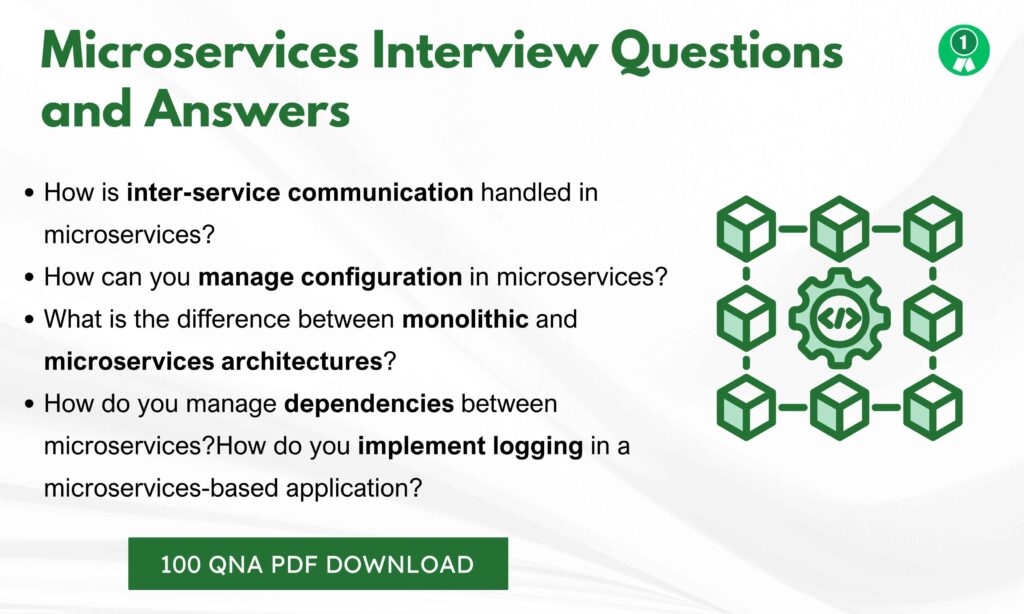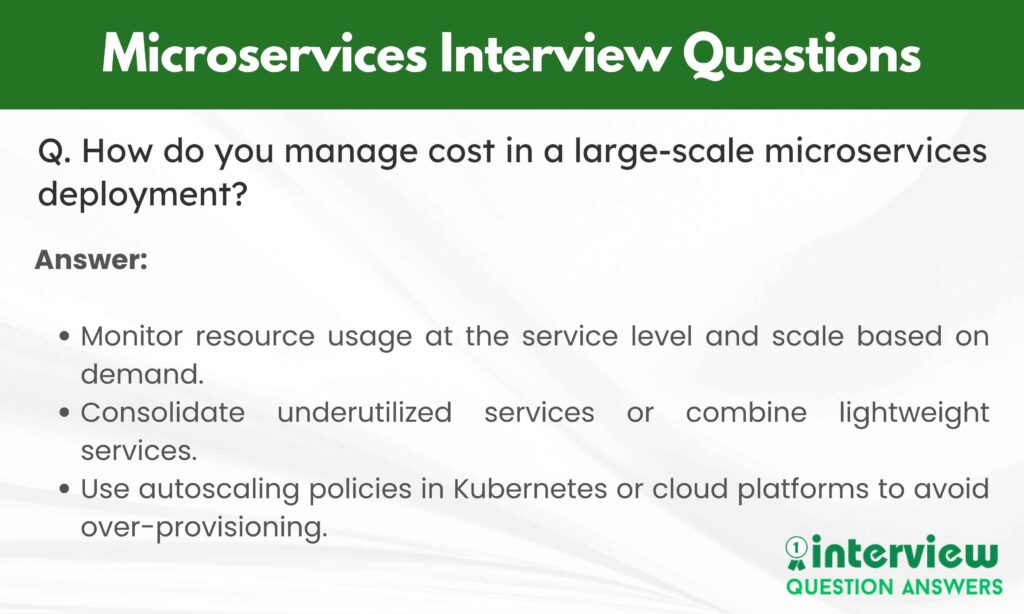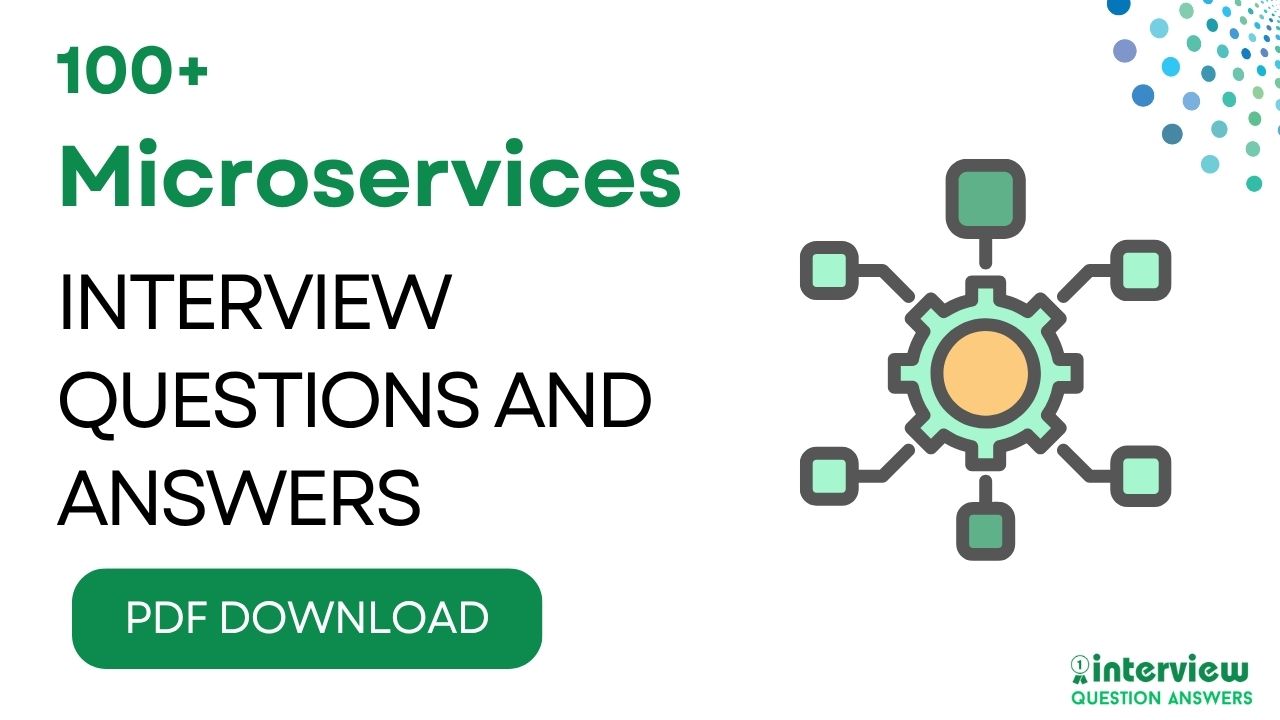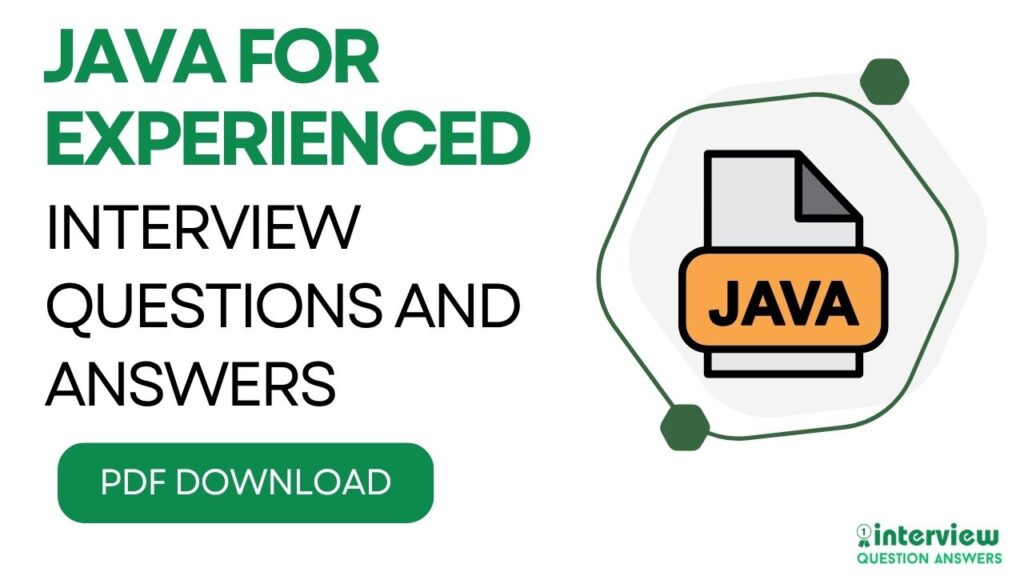Microservices architecture is a modern software design pattern where applications are broken down into small, independent services that communicate over APIs. Each microservice handles a specific business functionality and can be developed, deployed, and scaled independently. A microservices developer is responsible for designing these services, managing inter-service communication, ensuring data consistency, and deploying resilient and scalable systems using technologies like Spring Boot (Java) or .NET Core (C#).
As organizations move away from monolithic applications to cloud-native and containerized environments, microservices have become the backbone of modern enterprise systems. Employers look for engineers who understand concepts like API gateway, service discovery, circuit breakers, asynchronous messaging, and DevOps integration.
This guide presents a complete set of Microservices Interview Questions and Answers for freshers, experienced professionals, and includes language specific sections for Java, Spring Boot, and C# developers. These questions will help you strengthen your conceptual clarity, prepare for practical discussions, and succeed in your next microservices interview.
Table of Contents
Microservices Interview Questions and Answers for Freshers
Que 1. What are microservices and why are they used?
Answer:
Microservices are a software architecture style where an application is divided into small, independent services that communicate with each other using APIs. Each service is responsible for a specific business capability. Microservices are used to improve scalability, enable independent deployments, and allow teams to develop services in parallel using different technologies if needed.
Que 2. How is inter-service communication handled in microservices?
Answer:
Inter-service communication is usually handled in two ways:
- Synchronous communication using protocols like HTTP/REST or gRPC.
- Asynchronous communication using message brokers like RabbitMQ, Apache Kafka, or AWS SQS.
Choosing the right approach depends on latency requirements and the degree of coupling between services.
Que 3. What is the role of an API Gateway in microservices?
Answer:
An API Gateway acts as a single entry point for all client requests. It routes requests to the appropriate microservice and can also handle:
- Authentication and authorization
- Load balancing
- Request transformation and validation
- Rate limiting and caching
This simplifies the client-side logic and centralizes cross-cutting concerns.
Que 4. How can you manage configuration in microservices?
Answer:
Configuration can be managed centrally using tools like Spring Cloud Config, HashiCorp Consul, or AWS Parameter Store. Centralized configuration allows consistent property management across services, supports environment-specific settings, and can be updated without restarting services when integrated with dynamic refresh mechanisms.
Que 5. How do you handle service discovery in microservices?
Answer:
Service discovery is the process of dynamically locating services in a microservices ecosystem. It can be:
- Client-side discovery: Clients query a service registry (e.g., Eureka, Consul) to find available instances.
- Server-side discovery: Load balancers like AWS Elastic Load Balancing or Kubernetes handle routing automatically.
Que 6. What is the difference between monolithic and microservices architectures?
Answer: Microservices break an application into small, independently deployable services, whereas a monolithic architecture is a single, large codebase.
| Aspect | Monolithic Architecture | Microservices Architecture |
|---|---|---|
| Codebase | Single, large application | Multiple small services |
| Deployment | Entire app must be redeployed for any change | Individual services can be deployed independently |
| Scalability | Scales as a whole (less efficient) | Scales each service independently |
| Technology Stack | Usually one technology for the entire app | Each service can use a different technology stack |
Microservices offer better scalability and flexibility but add complexity in communication and management.
Que 7. What is the difference between monolithic and microservices architecture?
Answer:
- Monolithic: All components are tightly coupled and deployed as a single unit. Scaling requires replicating the entire application.
- Microservices: Each service is independent, can be scaled individually, and can be developed and deployed separately.
Microservices offer more flexibility but also introduce complexities in communication and data management.
Que 8. How do you secure microservices?
Answer:
- Implement centralized authentication and authorization using OAuth2 or OpenID Connect.
- Use API Gateways for token validation and role-based access control.
- Enable TLS for secure communication between services.
- Rotate secrets and use vaults like HashiCorp Vault or AWS Secrets Manager.
Que 9. How do you implement logging in a microservices-based application?
Answer:
- Use a centralized logging solution like ELK Stack (Elasticsearch, Logstash, Kibana) or Splunk.
- Include correlation IDs in logs to trace requests across services.
- Leverage libraries that automatically propagate tracing headers (e.g., Spring Cloud Sleuth).
Que 10. How can you monitor microservices in production?
Answer:
- Use metrics and monitoring tools like Prometheus, Grafana, or Datadog.
- Implement health checks for each service and expose them via endpoints.
- Collect distributed traces using tools like Zipkin or Jaeger.
Que 11. What is a circuit breaker in microservices?
Answer:
A circuit breaker prevents repeated calls to a failing service to avoid cascading failures. When failures cross a threshold, the circuit breaker trips and blocks further requests until the service is healthy again. Tools like Resilience4j and Hystrix are commonly used to implement this pattern.
Que 12. How can you handle asynchronous communication between services?
Answer:
- Use message brokers like RabbitMQ, Apache Kafka, or ActiveMQ.
- Publish events from one service and consume them in others.
- Ensure messages are durable and use dead-letter queues for failed messages.
Que 13. How do you handle database per service in microservices?
Answer:
Each microservice should have its own database to ensure loose coupling. Data consistency is achieved through event-driven updates or APIs. This approach prevents direct database coupling but requires designing services carefully to avoid data duplication issues.
Que 14. How do you manage dependencies between microservices?
Answer:
- Avoid tight coupling by defining clear API contracts.
- Use versioning strategies for APIs.
- Introduce asynchronous events to reduce synchronous dependencies.
- Apply the anti-corruption layer pattern to manage legacy systems or incompatible data models.
Que 15. How do you test microservices effectively?
Answer:
- Unit testing for individual components.
- Contract testing using tools like Pact to ensure APIs work as expected.
- Integration testing for service interactions.
- End-to-end testing in a staging environment.
Que 16. What is the role of containers in microservices?
Answer:
Containers like Docker package a microservice and its dependencies, ensuring consistent behavior across environments. Orchestrators like Kubernetes manage container deployment, scaling, and communication between services.
Que 17. How do you implement authentication and authorization in microservices?
Answer:
- Use a centralized identity provider (e.g., Keycloak, Auth0).
- Implement token-based authentication (JWT, OAuth2).
- Services validate tokens received via API Gateway or directly from clients.
Que 18. How do you handle failure and retries in microservices?
Answer:
- Use retry mechanisms with exponential backoff.
- Implement timeouts to avoid waiting indefinitely for a response.
- Use circuit breakers and fallbacks for partial failures.
- Ensure requests are idempotent to safely handle retries.
Que 19. How can you design APIs for microservices?
Answer:
- Follow REST or gRPC standards.
- Use descriptive endpoints and proper HTTP status codes.
- Version APIs to maintain backward compatibility.
- Provide clear documentation using tools like Swagger/OpenAPI.
Que 20. How do you handle deployment for microservices?
Answer:
- Use CI/CD pipelines for automated builds, tests, and deployments.
- Deploy using containers and orchestrators like Kubernetes.
- Apply blue-green or rolling deployments to minimize downtime.
Que 21. How can you achieve scalability in microservices?
Answer:
- Scale services independently based on resource usage.
- Use load balancers to distribute requests.
- Leverage caching to reduce load on downstream services.
- Utilize cloud-based auto-scaling features.
Que 22. How do you handle shared libraries in microservices?
Answer:
- Publish libraries as artifacts in a private repository (Maven, npm, PyPI).
- Keep libraries minimal to reduce dependencies.
- Update services independently when library versions change.
Que 23. How do you migrate from a monolithic architecture to microservices?
Answer:
- Identify boundaries and split the monolith into smaller services incrementally.
- Start with less critical services to reduce risk.
- Introduce an API Gateway and a message broker for communication.
- Refactor code to ensure each service owns its data.
Que 24. What is the importance of idempotency in microservices?
Answer:
Idempotency ensures that multiple identical requests do not cause unintended side effects. This is critical when retries occur. For example, processing a payment twice must be avoided. Implement idempotency by using unique request IDs and validating them before processing.
Que 25. How do you document microservices effectively?
Answer:
- Use OpenAPI/Swagger to auto-generate API documentation.
- Maintain versioned API docs for different service versions.
- Provide architectural diagrams and service dependency maps.
- Keep documentation in sync with code changes through automated pipelines.

Also Check: Spring Boot Interview Questions and Answers
Microservices Interview Questions and Answers for Experienced
Que 26. How do you design fault-tolerant microservices?
Answer:
Fault tolerance involves ensuring a microservice continues operating during failures. Approaches include:
- Using circuit breakers (Resilience4j, Hystrix) to prevent cascading failures.
- Implementing retries with exponential backoff and timeouts.
- Replicating services across multiple zones or regions.
- Storing events in queues for asynchronous processing.
Que 27. How do you handle distributed transactions in microservices?
Answer:
Distributed transactions are avoided when possible, but when needed, patterns like Saga or Outbox are used:
- Saga pattern: Each service performs a local transaction and triggers the next step. Failures are handled with compensating transactions.
- Outbox pattern: Write events and state changes in the same database transaction to ensure consistency before publishing.
Que 28. How do you secure service-to-service communication?
Answer:
- Use mutual TLS (mTLS) to encrypt traffic and authenticate services.
- Implement service meshes like Istio or Linkerd to manage certificates and enforce security policies.
- Validate JWT tokens on every request and enforce least privilege using scopes or claims.
Que 29. How do you manage secrets and configuration securely in microservices?
Answer:
- Store secrets in secure vaults like HashiCorp Vault, AWS Secrets Manager, or Azure Key Vault.
- Avoid hardcoding secrets in code or configuration files.
- Use dynamic secrets and rotate them regularly.
- Leverage centralized configuration systems with access control.
Que 30. How do you scale databases in a microservices architecture?
Answer:
- Partition databases per service (database-per-service pattern).
- Use sharding for horizontal scaling when a single database cannot handle the load.
- Implement caching layers (Redis, Memcached) to reduce database queries.
- Consider CQRS for separating read and write operations.
Que 31. How do you implement distributed tracing?
Answer:
- Use libraries like OpenTelemetry, Spring Cloud Sleuth, or Zipkin to add trace IDs to each request.
- Correlate logs, metrics, and traces across services using a centralized platform.
- Visualize service interactions in tracing tools like Jaeger to identify performance bottlenecks.
Que 32. What strategies do you use for zero-downtime deployments?
Answer:
- Blue-Green Deployment: Deploy a new version alongside the old one and switch traffic once tested.
- Rolling Updates: Gradually replace old instances with new ones.
- Canary Releases: Roll out to a small percentage of users first and monitor metrics before full rollout.
Que 33. How do you design APIs to minimize breaking changes?
Answer:
- Follow API versioning strategies (URI versioning, header-based versioning).
- Use backward-compatible changes (e.g., adding optional fields).
- Deprecate old endpoints with clear communication and timelines.
- Employ consumer-driven contract testing to validate compatibility.
Que 34. How do you design microservices for multi-tenancy?
Answer:
- Use database-per-tenant or schema-per-tenant strategies based on isolation requirements.
- Apply tenant-aware filters to every request.
- Leverage service meshes and policy engines to enforce tenant-specific resource limits.
Que 35. How do you handle eventual consistency in microservices?
Answer:
- Use event-driven architecture and ensure idempotency in consumers.
- Implement read models that can tolerate stale data until eventual synchronization.
- Use compensating actions in case of failure using Saga or workflows.
Que 36. How do you design a microservices architecture to handle partial failures?
Answer: Partial failures are inevitable in distributed systems, so resilience patterns must be applied.
| Pattern | Description |
|---|---|
| Circuit Breaker | Prevents calling a failing service repeatedly and allows it time to recover (e.g., Resilience4j) |
| Fallbacks | Provides an alternative response when a service is unavailable |
| Timeouts & Retries | Stops waiting indefinitely and retries failed requests with controlled intervals |
| Bulkheads | Isolates services/resources so one failure does not bring down the entire system |
Example using Resilience4j Circuit Breaker:
@CircuitBreaker(name = "orderService", fallbackMethod = "orderFallback")
public Order getOrder(String orderId) {
return restTemplate.getForObject("/orders/" + orderId, Order.class);
}
public Order orderFallback(String orderId, Throwable t) {
return new Order(orderId, "Pending - Service unavailable");
}These patterns ensure the system remains operational and degrades gracefully under failures.
Que 37. How do you implement bulkheads in microservices?
Answer:
- Isolate critical resources (threads, connection pools) for different services or features.
- Use dedicated thread pools for external calls so one slow dependency doesn’t block others.
- Monitor and scale resources independently.
Que 38. How do you implement idempotency in microservices?
Answer:
- Use unique request identifiers and reject duplicate requests.
- Implement state checks before performing write operations.
- Design APIs where repeating the same operation yields the same result without side effects.
Que 39. How do you manage backward compatibility of events?
Answer:
- Never remove required fields in event payloads.
- Add new fields as optional to maintain compatibility with older consumers.
- Use versioned topics or message formats for major changes.
Que 40. How do you test microservices in isolation and as a whole?
Answer:
- Unit tests for business logic.
- Contract testing using Pact for API compatibility.
- Integration testing with testcontainers for external dependencies.
- End-to-end testing with a staging environment simulating production.
Que 41. How do you handle large file processing in microservices?
Answer:
- Offload storage to object stores like AWS S3 or GCP Storage.
- Use pre-signed URLs to avoid direct file transfers through services.
- Process files asynchronously using event-driven workers.
Que 42. How do you design observability in microservices?
Answer:
- Implement structured logging with correlation IDs.
- Collect metrics at service and system levels with Prometheus.
- Use distributed tracing to capture service interactions and latencies.
- Set up alerting rules for critical service health metrics.
Que 43. How do you manage dependencies between services to avoid cascading failures?
Answer:
- Use asynchronous communication where possible.
- Implement circuit breakers, retries, and fallbacks.
- Prioritize critical services and degrade gracefully for non-critical ones.
Que 44. How do you integrate microservices with legacy systems?
Answer:
- Use the anti-corruption layer pattern to translate between models.
- Encapsulate legacy functionality behind APIs.
- Gradually extract and replace legacy modules into standalone microservices.
Que 45. How do you implement service mesh in microservices?
Answer:
- Deploy a service mesh like Istio or Linkerd to handle service-to-service communication.
- Offload traffic management, observability, and security from the application code.
- Use sidecar proxies for consistent policies across services.
Que 46. How do you handle schema migrations for distributed services?
Answer:
- Apply backward-compatible schema changes (e.g., adding nullable fields first).
- Use feature toggles to phase in changes gradually.
- Employ tools like Flyway or Liquibase for automated migrations.
Que 47. How do you optimize performance in a microservices architecture?
Answer:
- Minimize network hops by reducing synchronous dependencies.
- Cache responses and database queries.
- Use gRPC for low-latency communication where possible.
- Profile and remove resource bottlenecks using observability tools.
Que 48. How do you approach service orchestration vs. choreography?
Answer:
- Orchestration uses a central coordinator (e.g., Camunda, Temporal) to manage workflows.
- Choreography uses events for decentralized coordination.
- Choose orchestration when workflows are complex and choreography for loosely coupled services.
Que 49. How do you mitigate the challenges of data duplication in microservices?
Answer:
- Ensure consistency using event-driven updates and reconciliation jobs.
- Apply versioning to data records to prevent stale overwrites.
- Regularly audit and clean up duplicate data.
Que 50. How do you manage cost in a large-scale microservices deployment?
Answer:
- Monitor resource usage at the service level and scale based on demand.
- Consolidate underutilized services or combine lightweight services.
- Use autoscaling policies in Kubernetes or cloud platforms to avoid over-provisioning.

Also Check: Microservices Interview Questions for Experienced Professional
spring Boot Microservices Interview Questions and Answers
Que 51. How do you build a microservice using Spring Boot?
Answer:
Spring Boot makes building microservices straightforward:
- Use Spring Initializr to create a project with dependencies like Spring Web and Spring Data JPA.
- Define REST controllers using @RestController.
- Integrate with a dedicated database and use Spring Data for data access.
- Use Spring Cloud for service discovery, configuration, and communication.
- Package as a standalone JAR using the embedded Tomcat server or deploy as a Docker container.
Que 52. How do you enable service discovery in Spring Boot microservices?
Answer:
Service discovery is implemented using Netflix Eureka or Consul.
- Set up a discovery server using spring-cloud-starter-netflix-eureka-server and annotate it with @EnableEurekaServer.
- Register microservices as clients with spring-cloud-starter-netflix-eureka-client and @EnableEurekaClient.
- Services dynamically locate each other through the Eureka registry.
Que 53. How do you manage configuration centrally in Spring Boot microservices?
Answer:
- Use Spring Cloud Config Server to store configuration in external repositories like Git.
- Annotate configuration beans with @RefreshScope to refresh properties without restarting services.
- Protect sensitive data using Vault or encrypted properties.
Que 54. How do you implement an API Gateway for Spring Boot microservices?
Answer:
An API Gateway acts as a single entry point for all client requests and routes them to the appropriate microservice.
- Use Spring Cloud Gateway as the API Gateway.
- Add the dependency spring-cloud-starter-gateway in the project.
- Define routes in the application.yml file:
spring:
cloud:
gateway:
routes:
- id: order-service
uri: lb://ORDER-SERVICE
predicates:
- Path=/orders/**- You can also apply filters for authentication, rate limiting, logging, or request transformations at the gateway level.
Que 55. How do you secure Spring Boot microservices with OAuth2 and JWT?
Answer:
- Set up an authorization server (Keycloak, Okta, or Spring Authorization Server).
- Configure resource servers (microservices) with spring-boot-starter-oauth2-resource-server.
- Validate JWT tokens and implement role-based access control with Spring Security.
Que 56. How do you implement inter-service communication in Spring Boot microservices using Feign Client?
Answer: Feign Client is a declarative HTTP client used to simplify inter-service communication in Spring Boot microservices. It eliminates boilerplate RestTemplate code.
Example Feign Client:
@FeignClient(name = "payment-service")
public interface PaymentClient {
@GetMapping("/payments/{id}")
Payment getPayment(@PathVariable("id") String id);
}| Benefit | Description |
|---|---|
| Simplicity | Defines HTTP calls through interfaces |
| Load Balancing | Integrates with Ribbon or Spring Cloud LoadBalancer for client-side load balancing |
| Error Handling | Can integrate with Resilience4j or Hystrix for retries and circuit breaking |
This approach improves readability and reduces complexity in microservices communication.
Que 57. How do you implement centralized logging?
Answer:
- Use ELK Stack (Elasticsearch, Logstash, Kibana) or Splunk.
- Integrate Spring Cloud Sleuth to propagate trace IDs across logs.
- Forward logs from all microservices to a centralized logging system for debugging distributed transactions.
Que 58. How do you manage transactions across Spring Boot microservices?
Answer:
- Use the Saga pattern to break transactions into smaller, local transactions.
- Implement compensating actions for failure scenarios.
- Alternatively, use the Outbox pattern to ensure reliable event publishing along with database changes.
Que 59. How do you implement distributed tracing in Spring Boot microservices?
Answer:
- Add Spring Cloud Sleuth for automatic trace ID and span ID propagation.
- Connect Sleuth to Zipkin or Jaeger for visualization.
- Use distributed tracing to debug latency or request failures across multiple services.
Que 60. How do you perform health checks?
Answer:
- Include spring-boot-starter-actuator and use the /actuator/health endpoint.
- Create custom health indicators by implementing the HealthIndicator interface.
- Integrate with Kubernetes or Docker for automated restarts of unhealthy services.
Que 61. How do you implement circuit breakers?
Answer:
- Use Resilience4j with spring-cloud-starter-circuitbreaker.
- Annotate methods with @CircuitBreaker(name=”serviceName”, fallbackMethod=”fallback”).
- Circuit breakers prevent cascading failures by temporarily halting requests to failing services.
Que 62. How do you implement load balancing?
Answer:
- Use Spring Cloud LoadBalancer for client-side load balancing with Eureka.
- Server-side load balancing is handled by orchestration tools like Kubernetes or cloud-native solutions (AWS ELB, Azure ALB).
- Combine with API Gateway for effective traffic routing.
Que 63. How do you handle asynchronous messaging?
Answer:
- Use Spring Cloud Stream with Kafka or RabbitMQ.
- Bind input and output channels with @EnableBinding or functional APIs.
- Configure dead-letter queues for error handling and ensure message durability.
Que 64. How do you containerize Spring Boot microservices?
Answer:
- Create a Dockerfile with a lightweight JDK base image:
FROM openjdk:17-jdk-alpine
COPY target/app.jar app.jar
ENTRYPOINT ["java","-jar","/app.jar"]- Build and push the Docker image to a container registry.
- Deploy using Kubernetes or Docker Compose for orchestration.
Que 65. How do you manage dependencies between microservices?
Answer:
- Use API contracts and consumer-driven contract testing with Pact.
- Version APIs carefully to avoid breaking clients.
- Prefer asynchronous communication to reduce tight coupling.
Que 66. How do you handle data consistency?
Answer:
- Adopt the database-per-service pattern to maintain service boundaries.
- Use eventual consistency through events for data synchronization.
- Implement idempotency in APIs to manage retries safely.
Que 67. How do you monitor Spring Boot microservices?
Answer:
- Use Spring Boot Actuator to expose health and metrics endpoints.
- Collect metrics with Prometheus and visualize with Grafana.
- Set up alerting for latency spikes, failures, and resource overuse.
Que 68. How do you achieve zero-downtime deployments?
Answer:
- Use rolling updates or blue-green deployment strategies.
- Ensure backward compatibility in API and database changes.
- Apply schema migration tools like Flyway or Liquibase.
Que 69. How do you implement rate limiting?
Answer:
- Configure rate limiting at the API Gateway using filters.
- Use Resilience4j RateLimiter for fine-grained service-level rate limiting.
- Store counters in Redis for distributed environments.
Que 70. How do you integrate Spring Boot microservices with cloud platforms?
Answer:
- Use Spring Cloud AWS, Azure, or GCP libraries for cloud-native integrations.
- Leverage managed services for storage, messaging, and databases.
- Utilize auto-scaling and cloud load balancing for better performance.
Also Check: Spring Boot Interview Questions for Experienced Professional
Java Microservices Interview Questions and Answers
Que 71. How do you design Java microservices for scalability?
Answer:
- Break down the application into independent services based on business capabilities.
- Use stateless services wherever possible to allow horizontal scaling.
- Implement database-per-service architecture to avoid resource contention.
- Utilize containerization (Docker) and orchestration (Kubernetes) for dynamic scaling.
- Adopt asynchronous communication with message brokers (Kafka, RabbitMQ) to handle load spikes gracefully.
Que 72. How do you implement service discovery in Java microservices?
Answer:
- Use Netflix Eureka, Consul, or Zookeeper as the discovery server.
- Register each microservice with the discovery server during startup.
- Access other services through the discovery client rather than hardcoding URLs.
- For Spring-based services, use Spring Cloud Netflix Eureka with @EnableEurekaServer on the server and @EnableEurekaClient on clients.
Que 73. How do you manage configurations across multiple microservices?
Answer:
- Externalize configuration using Spring Cloud Config, HashiCorp Consul, or AWS Parameter Store.
- Store sensitive information securely using Vault or encrypted properties.
- Refresh configurations dynamically using @RefreshScope in Spring Cloud Config without restarting services.
Que 74. How do you handle inter-service communication?
Answer:
- Use synchronous calls with Feign Client or WebClient when real-time responses are needed.
- Prefer asynchronous messaging using Kafka, RabbitMQ, or ActiveMQ for decoupling services.
- Implement retries and fallback mechanisms to handle failures gracefully.
Que 75. How do you implement API Gateway in Java microservices?
Answer:
- Use Spring Cloud Gateway, Zuul, or Kong as an API Gateway.
- Route requests to underlying services based on path or headers.
- Apply cross-cutting concerns like authentication, rate limiting, and logging at the gateway level.
- Example configuration using Spring Cloud Gateway in application.yml:
spring:
cloud:
gateway:
routes:
- id: user-service
uri: lb://USER-SERVICE
predicates:
- Path=/users/**Que 76. How do you implement asynchronous communication between Java microservices?
Answer: Asynchronous communication is usually implemented using message brokers like Kafka, RabbitMQ, or ActiveMQ. This decouples services and improves scalability.
Example using Spring Boot with RabbitMQ:
// Producer
rabbitTemplate.convertAndSend("orderExchange", "order.created", order);
// Consumer
@RabbitListener(queues = "orderQueue")
public void receiveOrder(Order order) {
processOrder(order);
}| Benefit | Description |
|---|---|
| Decoupling | Producers and consumers are independent |
| Improved Scalability | Services can scale independently based on message load |
| Reliability | Messages can be persisted and retried in case of failure |
This approach is ideal for microservices that do not require immediate responses and must handle high traffic.
Que 77. How do you ensure data consistency across microservices?
Answer:
- Implement the Saga pattern to manage distributed transactions with compensating actions.
- Use event sourcing to rebuild system state from event history.
- Ensure APIs are idempotent to avoid inconsistent states during retries.
Que 78. How do you implement centralized logging?
Answer:
- Use ELK Stack (Elasticsearch, Logstash, Kibana) or Splunk for centralized logging.
- Add correlation IDs to logs using frameworks like Spring Cloud Sleuth.
- Send structured JSON logs from microservices to simplify analysis.
Que 79. How do you monitor Java microservices?
Answer:
- Use Spring Boot Actuator to expose health and metrics endpoints.
- Collect metrics using Prometheus and visualize them in Grafana.
- Set up distributed tracing with Zipkin or Jaeger to track requests across services.
Que 80. How do you handle failures in inter-service communication?
Answer:
- Implement circuit breakers using Resilience4j to stop cascading failures.
- Configure retries with exponential backoff for transient errors.
- Use bulkheads and timeouts to isolate failures to a single service.
Que 81. How do you containerize Java microservices?
Answer:
- Create a Dockerfile with a lightweight JDK base image:
FROM openjdk:17-jdk-alpine
COPY target/app.jar app.jar
ENTRYPOINT ["java", "-jar", "/app.jar"]- Build and push the Docker image to a registry.
- Deploy using Docker Compose for local setups or Kubernetes for production.
Que 82. How do you version APIs in microservices?
Answer:
- Include versioning in the URL path (e.g., /api/v1/users) or headers.
- Deprecate older versions gradually to give clients time to migrate.
- Maintain backward compatibility whenever possible to avoid breaking changes.
Que 83. How do you test Java microservices effectively?
Answer:
- Write unit tests using JUnit and Mockito.
- Use Spring Boot Test for integration tests.
- Perform contract testing with Pact to ensure compatibility between services.
- Run end-to-end tests using tools like RestAssured or Postman collections.
Que 84. How do you achieve zero-downtime deployments?
Answer:
- Use blue-green or rolling deployment strategies with Kubernetes.
- Maintain backward compatibility in database and API changes.
- Use feature toggles to control the rollout of new functionality safely.
Que 85. How do you implement rate limiting?
Answer:
- Apply rate limiting at the API Gateway using filters.
- Use token bucket or leaky bucket algorithms with libraries like Bucket4j.
- Store counters in distributed caches like Redis for multi-node setups.
Que 86. How do you handle database-per-service architecture?
Answer:
- Each service owns its database to maintain loose coupling.
- Use data replication or event-driven synchronization for cross-service data needs.
- Avoid direct database calls between services to maintain independence.
Que 87. How do you migrate monolithic Java applications to microservices?
Answer:
- Identify independent business domains and break them into microservices gradually.
- Extract services one at a time and introduce an API Gateway to manage traffic.
- Decouple shared databases and move toward database-per-service.
- Automate CI/CD pipelines to handle frequent deployments.
Que 88. How do you manage dependencies and library versions across services?
Answer:
- Use dependency management tools like Maven BOM or Gradle platform.
- Maintain internal artifact repositories (Nexus, Artifactory) for shared libraries.
- Standardize Java and Spring Boot versions across teams to avoid conflicts.
Que 89. How do you handle asynchronous event-driven architecture in Java microservices?
Answer:
- Use Spring Cloud Stream to bind microservices to messaging platforms like Kafka or RabbitMQ.
- Implement dead-letter queues for failed messages.
- Ensure messages are idempotent and design for eventual consistency.
Que 90. How do you implement configuration changes without restarting Java microservices?
Answer:
- Use Spring Cloud Config Server to externalize configuration from the codebase.
- Annotate beans with @RefreshScope so they reload configuration dynamically.
- Trigger the /actuator/refresh endpoint manually or use Spring Cloud Bus with a message broker (Kafka or RabbitMQ) to propagate configuration changes automatically.
- Ensure sensitive information like passwords is encrypted and stored securely in Vault or AWS Secrets Manager
Also Check: Java interview Questions and Answers
Microservices C# Interview Questions and Answers
Que 91. How do you implement service discovery in C# microservices?
Answer:
- Use tools like Consul, Eureka, or Kubernetes service discovery for dynamic service registration.
- For .NET Core applications, integrate Steeltoe with Eureka or use Consul’s .NET client library.
- Service discovery allows services to locate each other without hardcoded URLs, improving flexibility and scalability.
Que 92. How do you handle inter-service communication in C# microservices?
Answer:
- For synchronous communication, use HTTP-based REST APIs with HttpClientFactory in .NET Core to manage connections efficiently.
- For asynchronous communication, use message brokers like Azure Service Bus, RabbitMQ, or Kafka with libraries like MassTransit or NServiceBus.
- Implement retry policies, timeouts, and fallbacks to handle failures gracefully.
Que 94. How do you centralize configuration management in C# microservices?
Answer:
- Use Azure App Configuration, Consul, or HashiCorp Vault to externalize configuration.
- For .NET Core, integrate Microsoft.Extensions.Configuration to pull settings dynamically from these stores.
- Refresh configurations at runtime using IOptionsSnapshot or reload tokens without restarting services.
Que 95. How do you implement API Gateway in C# microservices?
Answer:
- Use Ocelot as a lightweight API Gateway in .NET Core projects.
- Define routing, authentication, and rate limiting in the ocelot.json configuration file.
- Example of Ocelot route configuration:
{
"Routes": [
{
"DownstreamPathTemplate": "/api/user/{everything}",
"UpstreamPathTemplate": "/user/{everything}",
"DownstreamScheme": "http",
"DownstreamHostAndPorts": [
{ "Host": "localhost", "Port": 5001 }
]
}
]
}Que 96. How do you monitor and log C# microservices?
Answer:
- Use Serilog or NLog for structured logging and send logs to centralized platforms like ELK Stack or Azure Monitor.
- Enable distributed tracing using OpenTelemetry with exporters like Jaeger or Zipkin.
- Collect health metrics using Prometheus or Application Insights to detect issues early.
Que 97. How can you ensure secure communication between Java microservices?
Answer: Secure communication is typically achieved using HTTPS with TLS and token-based authentication. You can also use mTLS (Mutual TLS) for two-way verification.
| Security Mechanism | Description |
|---|---|
| HTTPS with TLS | Encrypts data in transit to prevent eavesdropping |
| OAuth 2.0 / JWT Tokens | Ensures only authenticated users or services can access APIs |
| API Gateway Integration | Centralizes authentication and authorization at a single entry point |
| Mutual TLS (mTLS) | Both client and server authenticate each other using certificates |
Example of enabling HTTPS in Spring Boot (Java microservices):
server.port=8443
server.ssl.key-store=classpath:keystore.p12
server.ssl.key-store-password=changeit
server.ssl.keyStoreType=PKCS12
server.ssl.keyAlias=tomcatThis configuration ensures that all traffic is encrypted between services.
Que 98. How do you handle versioning of APIs in C# microservices?
Answer:
- Use Microsoft.AspNetCore.Mvc.Versioning package to manage API versions.
- Support versioning via URL segments (e.g., /api/v1/users) or HTTP headers.
- Deprecate old versions carefully and maintain backward compatibility.
Que 99. How do you containerize and deploy C# microservices?
Answer:
- Create a Dockerfile using the official .NET runtime and SDK images:
FROM mcr.microsoft.com/dotnet/aspnet:7.0 AS base
WORKDIR /app
COPY . .
ENTRYPOINT ["dotnet", "MyService.dll"]- Push Docker images to Azure Container Registry or Docker Hub.
- Deploy using Kubernetes, Azure Kubernetes Service (AKS), or AWS ECS for orchestration.
Que 100. How do you implement fault tolerance in C# microservices?
Answer:
- Use Polly for retry policies, circuit breakers, and bulkhead isolation in .NET Core.
- Combine circuit breakers with timeouts to prevent cascading failures.
- Implement fallback mechanisms to handle degraded functionality gracefully.
Also Check: C# Interview Questions and Answers
Microservices Interview Questions PDF
You can also download our special PDF version that works great on phones, tablets, and computers, making it super easy to study during your free time.
FAQs: Microservices Interview Questions
What job roles typically require knowledge of Microservices Interview Questions and Answers?
Professionals applying for roles like Microservices Developer, Backend Engineer, Cloud-Native Developer, DevOps Engineer, and Solution Architect are frequently asked microservices-related questions. These roles require strong skills in distributed systems, containerization, API development, and cloud platforms.
What challenges should I expect during microservices job interviews?
Candidates often face questions on real-world scenarios like handling inter-service communication failures, implementing distributed transactions, and ensuring scalability. Many interviews involve practical tasks such as designing a microservices architecture or writing code to demonstrate asynchronous communication.
What are common on-the-job challenges in microservices roles?
Microservices professionals deal with complex deployments, data consistency issues, and performance monitoring across distributed environments. They must also ensure proper security and API versioning while balancing the need for independent service releases.
What is the average salary for microservices-related roles in the USA?
The average salary for professionals with strong microservices expertise in the USA ranges between $110,000 and $150,000 annually. Senior engineers and architects with cloud and DevOps experience can earn upwards of $160,000, depending on the company and location.
Which top companies hire for microservices-based roles?
Companies like Amazon, Microsoft, Google, Netflix, JPMorgan Chase, Walmart, and IBM actively hire developers and architects with microservices expertise. Many mid-sized tech companies and startups also prefer candidates skilled in building cloud-native applications.
How can I prepare for microservices interviews effectively?
Focus on understanding microservices architecture patterns, API Gateway implementation, containerization with Docker and Kubernetes, and common frameworks (Spring Boot, .NET Core, Node.js). Practice solving design problems and prepare to explain trade-offs in real-world scenarios.
Is microservices experience valuable for career growth?
Yes, microservices experience is highly valuable, especially as most companies move toward cloud-native and scalable application designs. It opens doors to senior technical roles, cloud solution architect positions, and high-demand jobs in DevOps and backend development.
Conclusion
This microservices interview guide helps you prepare for software development job interviews with questions for both new and experienced developers. We included questions about microservices architecture and distributed systems that companies build today. Use this guide to practice and become confident with microservices interview questions and prepare your answers.







